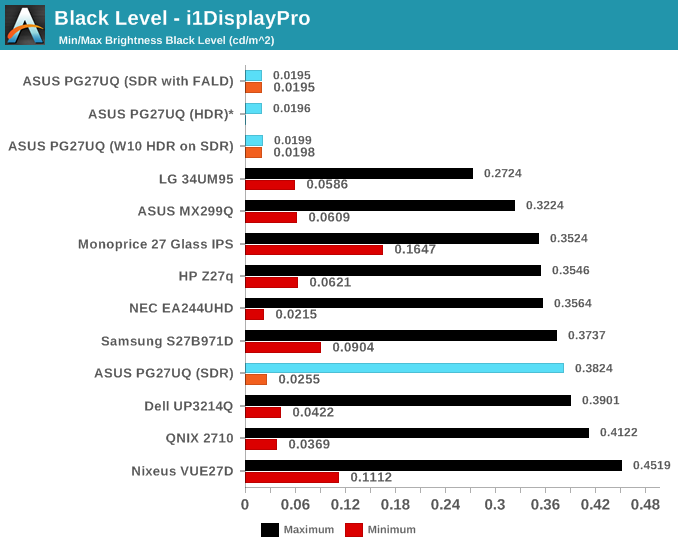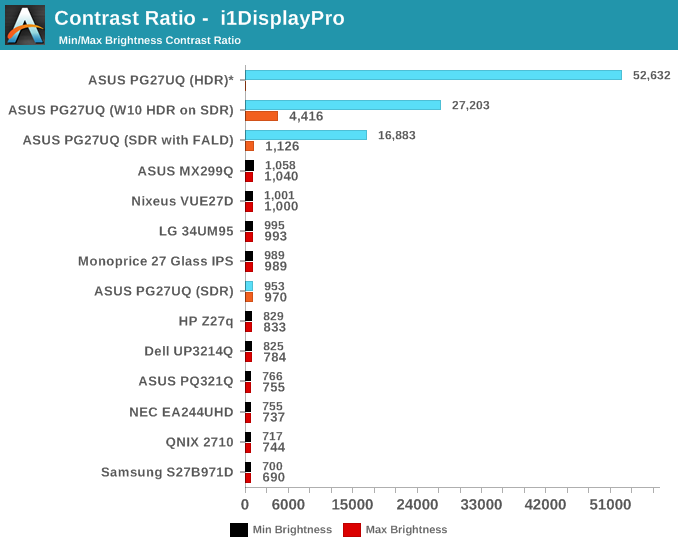The Asus ROG Swift PG27UQ G-SYNC HDR Monitor Review: Gaming With All The Bells and Whistles
by Nate Oh on October 2, 2018 10:00 AM EST- Posted in
- Monitors
- Displays
- Asus
- NVIDIA
- G-Sync
- PG27UQ
- ROG Swift PG27UQ
- G-Sync HDR
Brightness and Contrast
Going straight into the brightness and contrast metrics, we know HDR's calling card is to permit those bright whites and dark blacks. For DisplayHDR 1000, and UHD Premium, 1000 nits (the common non-SI term for cd/m2) is the requirement. So for brightness of white levels, it's no surprise that in HDR mode the PG27UQ reaches that coveted mark.
Outside of HDR, brightness is also useful in gauging visibility/usability in conditions of bright and direct ambient light, i.e. outdoors. For moderately lit indoor use, the typical 200 to 300 nit range of desktop monitors is more than sufficient. In terms of factory defaults, the PG27UQ is set at 80 for brightness, which is around 266 nits. 1000 nits is much too bright for day-to-day usage, as is 500 nits.

*In HDR mode, there is an adjustable 'reference white' setting, defaulted at 80 nits, instead of a brightness setting. At that default setting, the PG27UQ displayed the HDR test pattern at 1032 nits.
Because HDR has a static 'reference white' level instead of brightness, there isn't really an equivalent to minimum brightness white level as it isn't utilized in the same way; for the PG27UQ, reference white can be set between 20 to 300 nits.
Otherwise, enabling the Windows 10 'HDR and Wide Color Gamut' mode puts the monitor into its HDR mode; additionally, that Windows 10 setting provides a brightness slider governing SDR content while in HDR mode. So at 100% SDR brightness, the display pushes past 500 nits. For users, it works nicely to avoid SDR dimness when HDR is enabled, and also providing the option to boost up to much higher brightness if desired.

*Represents black levels corresponding to the default 'reference white' setting of 80 nits.
IPS-type panels are often known for their 'backlight bleed' and so relatively higher black levels. Without its local dimming capability, the PG27UQ isn't much of an exception. Enabling variable backlighting (FALD) in the OSD brings the black levels to HDR tier performance, and can be enabled on SDR mode at the cost of maximum brightness white levels.

*Contrast ratios calculated from default reference white of 80 nits
The good range between bright whites and dark blacks translate into high contrast ratios for the PG27UQ. While we don't have any other HDR monitors for comparison, the contrast ratios are really in their own class, especially as only HDR content will take advantage of the brightness and be (properly) displayed. Otherwise, in pure SDR mode, the PG27UQ resembles a solid IPS-type SDR monitor. Just enabling the direct LED backlighting in SDR mode improves contrasts considerably on the strength of its black levels.










91 Comments
View All Comments
Ryan Smith - Wednesday, October 3, 2018 - link
Aye. The FALD array puts out plenty of heat, but it's distributed, so it can be dissipated over a large area. The FPGA for controlling G-Sync HDR is generates much less heat, but it's concentrated. So passive cooling would seem to be non-viable here.a5cent - Wednesday, October 3, 2018 - link
Yeah, nVidia's DP1.4 VRR solution is baffelingly poor/non-competitive, not just due to the requirement for active cooling.nVidia's DP1.4 g-sync module is speculated to contribute a lot to the monitor's price (FPGA alone is estimated to be ~ $500). If true, I just don't see how g-sync isn't on a path towards extinction. That simply isn't a price premium over FreeSync that the consumer market will accept.
If g-sync isn't at least somewhat widespread and (via customer lock in) helping nVidia sell more g-sync enabled GPUs, then g-sync also isn't serving any role for nVidia. They might as well drop it and go with VESA's VRR standard.
So, although I'm actually thinking of shelling out $2000 for a monitor, I don't want to invest in technology it seems has priced itself out of the market and is bound to become irrelevant.
Maybe you could shed some light on where nVidia is going with their latest g-sync solution? At least for now it doesn't seem viable.
Impulses - Wednesday, October 3, 2018 - link
How would anyone outside of NV know where they're going with this tho? I imagine it does help sell more hardware to one extent or another (be it GPUs, FPGAs to display makers, or a combination of profits thru the side deals) AND they'll stay the course as long as AMD isn't competitive at the high end...Just the sad reality. I just bought a G-Sync display but it wasn't one of these or even $1K, and it's still a nice display regardless of whether it has G-Sync or not. I don't intend to pay this kinda premium without a clear path forward either but I guess plenty of people are or both Acer and Asus wouldn't be selling this and plenty of other G-Sync displays with a premium over the Freesync ones.
a5cent - Wednesday, October 3, 2018 - link
"How would anyone outside of NV know where they're going with this tho?"Anandtech could talk with their contacts at nVidia, discuss the situation with monitor OEMs, or take any one of a dozen other approaches. Anandtech does a lot of good market research and analysis. There is no reason they can't do that here too. If Anandtech confronted nVidia with the concern of DP1.4 g-sync being priced into irrelevancy, they would surely get some response.
"I don't intend to pay this kinda premium without a clear path forward either but I guess plenty of people are or both Acer and Asus wouldn't be selling this and plenty of other G-Sync displays with a premium over the Freesync ones."
You're mistakenly assuming the DP1.2 g-sync is in any way comparable to DP1.4 g-sync. It's not.
First, nobody sells plenty of g-sync monitors. The $200 price premium over FreeSync has made g-sync monitors (comparatively) low volume niche products. For DP1.4 that premium goes up to over $500. There is no way that will fly in a market where the entire product typically sells for less than $500. This is made worse by the fact that ONLY DP1.4 supports HDR. That means even a measly DisplayHDR 400 monitor, which will soon retail for around $400, will cost at least $900 if you want it with g-sync.
Almost nobody, for whom price is even a little bit of an issue, will pay that.
While DP1.2 g-sync monitors were niche products, DP1.4 g-sync monitors will be irrelevant products (in terms of market penetration). Acer's and Asus' $2000 monitors aren't and will not sell in significant numbers. Nothing using nVidia's DP1.4 g-sync module will.
To be clear, this isn't a rant about price. It's a rant about strategy. The whole point of g-sync is customer lock-in. Nobody, not even nVidia, earns anything selling g-sync hardware. For nVidia, the potential of g-sync is only realized when a person with a g-sync monitor upgrades to a new nVidia card who would otherwise have bought an AMD card. If DP1.4 g-sync isn't adopted in at least somewhat meaningful numbers, g-sync loses its purpose. That is when I'd expect nVidia to either trash g-sync and start supporting FreeSync, OR build a better g-sync module without the insanely expensive FPGA.
Neither of those two scenarios motivates me to buy a $2000 g-sync monitor today. That's the problem.
a5cent - Wednesday, October 3, 2018 - link
To clarify the above...If I'm spending $2000 on a g-sync monitor today, I'd like some reassurance that g-sync will still be relevant and supported three years from now.
For the reasons mentioned, from where I stand, g-sync looks like "dead technology walking". With DP1.4 it's priced itself out of the market. I'm sure many would appreciate some background on where nVidia is going with this...
lilkwarrior - Monday, October 8, 2018 - link
Nvidia's solution is objectively better besides not being open. Similarly NVLINK is better than any other multi-GPU hardware wise.With HDMI 2.1, Nvidia will likely support it unless it's simply underwhelming.
Once standards catch up, Nvidia hasn't been afraid to deprecate their own previous effort somewhat besides continuing to support it for wide-spread support / loyalty or a balanced approach (i.e. NVLINK for Geforce cards but delegate memory pooling to DX12 & Vulkan)
Impulses - Tuesday, October 2, 2018 - link
If NVidia started supporting standard adaptive sync at the same time that would be great... Pipe dream I know. Things like G-Sync vs Freesync, fans inside displays, and dubious HDR support don't inspire much confidence in these new displays. I'd gladly drop the two grand if I *knew* this was the way forward and would easily last me 5+ years, but I dunno if that would really pan out.DanNeely - Tuesday, October 2, 2018 - link
Thank you for including the explanation on why DSC hasn't shown up in any products to date.Heavenly71 - Tuesday, October 2, 2018 - link
I'm pretty disappointed that a gaming monitor with this price still has only 8 bits of native color resolution (plus FRC, I know).Compare this to the ASUS PA32UC which – while not mainly targetted at gamers – has 10 bits, no fan noise, is 5 inches bigger (32" total) and many more inputs (including USB-C DP). For about the same price.
milkod2001 - Tuesday, October 2, 2018 - link
Wonder if they make native 10bit monitors. Would you be able to output 10bit colours from gaming GPU or only professional GPU?